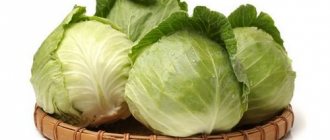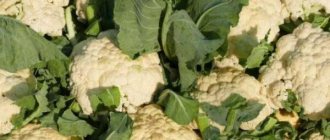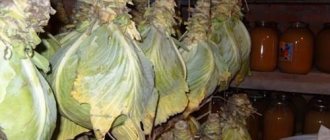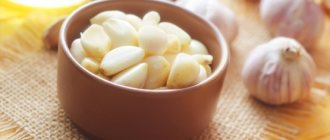How to choose the right one
Late varieties of the crop that are grown in the local climate and not imported from Asian countries are suitable for storage. Cut before mid-October:
- Asten;
- Wineglass;
- Magician;
- Fortune teller;
- Princess.
It is necessary to allow the Chinese cabbage to freeze, since it will not lie. When optimal conditions are created, tight heads of cabbage without damage and evenly colored do not rot for a long time. Crumpled and limp leaves should be torn off immediately, since they harbor fungi that quickly spread and cause rotting.
Optimal storage conditions
Fresh Chinese cabbage cannot be kept in the pantry or kitchen, as it wilts in a few days.
Temperature
Even dense and tight heads of cabbage do not stay warm and quickly lose their presentation. Forks are normally stored in the basement, where it is no higher than +3 °C.
Humidity
Cabbage leaves wither not only because of the high temperature in the room; the heads do not tolerate dry air. In order for the product to remain juicy, the humidity in the storage should not be less than 93. When the indicator increases to 97–98%, the heads of cabbage begin to rot.
See also
How to properly store food in the refrigerator and on which shelves, organization diagrams
Illumination
Before storing Chinese cabbage in a basement or cellar, it is disinfected with special disinfection solutions. The vegetable does not tolerate sunlight; it is better to lie in a dark place.
Ventilation
Storage for Chinese cabbage should be well ventilated. If the air stagnates, the heads quickly deteriorate. To prevent the heads of cabbage from rotting or withering, it is allowed to remove only 2 leaves from the top.
Errors
The main mistakes housewives make when preparing cabbage for storage:
- You can’t put vegetables in the same container or next to apples and bananas. They produce ethylene, so cabbage leaves will spoil quickly;
- packing the crushed leaves into a storage container;
- chopping causes moisture loss;
- removing a large number of leaves from the head of cabbage.
Such actions will accelerate the withering of the product and reduce its shelf life.
Methods of storage and preparation for the winter
In the absence of a cellar, when a good harvest is collected, vegetables are salted and pickled; Chinese cabbage can also be processed.
Leaven
Most people are accustomed to eating this dietary product in salads; the tender and juicy leaves give the popular “Caesar” a special piquancy. Peking cabbage does not crunch in marinade or brine, but it turns out no less tasty than the usual white cabbage varieties.
For the starter you need to take 1 or 2 heads with a total weight of 3 kg, in addition, you will need:
- sugar;
- chilli;
- ginger powder;
- garlic.
The heads of cabbage are divided into 4 parts, the leaves are rubbed with salt and placed in an enamel or glass deep bowl, left in the kitchen for a day, after which they are washed under the tap and soaked in cool water for 3 or 4 hours. The liquid is drained by placing the Chinese cabbage in a colander.
Pepper is combined with crushed garlic and ginger powder. Each leaf is treated separately with hot seasoning. Transfer the vegetable mixture into a plastic container and leave it warm for a day, periodically removing the lid to let the air out. After this, the container is sent to a cool place. Cabbage will ferment in 10–14 days.
Drying
Petsai is stored for a long time and does not lose useful components when stored for the winter in another way. Having removed the top leaves, the head of cabbage is chopped or chopped into pieces, placed on a baking sheet covered with parchment, put in the oven, set to 50 °C.
Chinese cabbage dries well in a special electric dryer. It is placed on the pallet and the device is turned on.
Fresh
There are several ways.
In vegetable stores
For significant volumes of agricultural products, a warehouse is used, in which a cooling system maintains a certain temperature, and ventilation is carried out using exhaust ventilation. In the vegetable storehouse, potatoes, onions, and beets do not lose their taste, attractive appearance or useful components.
See also
Is it possible to keep bread in the refrigerator, rules and shelf life
Peking cabbage cut in dry weather is placed in containers, boxes or placed in bulk with the stalk facing up. Fruits that emit ethylene should not be placed near petsai. At 0–2 °C, the dietary product remains fresh for more than 3 months; at 4 degrees, it germinates and rots.
Basement or cellar
A vegetable storage facility, equipped with a ventilation and cooling system, is usually rented by farmers cultivating their fields. Owners of summer cottages and vegetable gardens place their produce in the cellar.
In limbo
If there is not enough space in the basement and everything is filled with boxes with root vegetables, some owners stretch thin wire or rope under the ceiling and hang Chinese cabbage leaves down.
In sand
If you need to keep the petsai fresh for as long as possible, you do not need to cut off the heads of cabbage, but dig up the vegetable plant along with the roots, lower it into the cellar, plant it in the sand and regularly water it a little.
In the box
Housewives want to please their family longer with vitamin-rich Chinese cabbage salads, so they wrap each head in film and place it in bags, which they place loosely in a box.
Balcony
In an apartment, the leaves of a dietary product wither quickly; it is impossible to store the entire harvest collected in the garden in the refrigerator. Peking cabbage sits well on a glassed-in balcony. Heads of cabbage need to be constantly inspected and any dried or rotting ones removed. The heads must be protected from frost and protected from the rays of the sun.
In a refrigerator
The temperature on an unheated balcony or loggia often changes, sometimes rising to 20, sometimes dropping below 0, which negatively affects the appearance of Chinese cabbage. Vegetables are best stored in the refrigerator. From heads that cannot be washed, cut off the stalk, wrap them in paper, leave them in a cool room for 3 hours, and then place them on a shelf or in a refrigerator drawer.
Freezer
You can save Chinese cabbage until the next harvest. Ripe, dense heads of cabbage are washed under the tap, the juicy leaves are separated, chopped into pieces and dipped in salted boiling water for a couple of minutes. Removed from the liquid, the chopped cabbage is dried on a towel, cooled at sub-zero temperatures, and placed in bags that are placed in the freezer.
See also
TOP 15 ways to properly store garlic at home
Salting and marinating
A very tasty, healthy snack made from petsai lasts well until winter if the proportions of the main ingredients used are respected. For a kilogram of cabbage, take 1/2 cup of rock salt. Also required:
- Bay leaf;
- sweet peas;
- clove buds.
Petsai is chopped into thin strips with a knife, mechanical or electric shredder. The slices are mixed with salt, combined with spices and transferred to a glass container. The container is wrapped in gauze and pressure is applied. Over the course of a month, the cabbage becomes salted, but over time it becomes even tastier and spicier.
Canned vegetables do not spoil much longer than fresh vegetables. Pickled Chinese cabbage will not leave anyone indifferent. For the workpiece take:
- head weighing 0.5 kg;
- ½ cup vinegar;
- 40 g sugar;
- chilli;
- salt - 3 tbsp. l.
The head of cabbage is washed under the tap and chopped into strips. 0.5 liters of water are poured into a bowl and a marinade is made together with spices; vinegar is added to the boiling liquid.
Place cabbage at the bottom of a glass container, pour in a hot solution, seal it hermetically and insulate it with a blanket.
How to store Chinese cabbage at home
You can preserve the vegetable in different ways so that you can prepare dishes using it in the winter. In an apartment or house, it can be stored in the refrigerator, basement or on the balcony, while observing certain rules.
How to ferment Chinese cabbage
One of the most popular recipes for pickling vegetables is kimchi (Korean style). To ferment cabbage you will need additional ingredients:
- salt;
- sugar;
- onion;
- garlic;
- red pepper;
- water.
First prepare the brine. To do this, pour 1 tbsp into 1 liter of water. salt and place the container on the fire. Stirring constantly, you need to wait until the salt dissolves. Then the brine is removed from the heat and left to cool. At this time, the head of cabbage is freed from spoiled leaves and cut lengthwise for 4 hours, cutting out the stalk. The remaining leaves, the total weight of which should be 1 kg, are cut into thin strips. Chop 50-100 g of onion. The chopped vegetables are mixed in a saucepan or large bowl and poured with brine. The container is covered with a plate on top, on which a load is placed.
After 2 days, take out the pekin leaves and grease them with pre-prepared seasoning (mix 2 tablespoons of ground red pepper, juice of 6 cloves of garlic, 1 teaspoon of sugar). After this, the cabbage is again placed in a container with freshly prepared brine under pressure for 2 days. The prepared sauerkraut can be placed in screw-on jars and left in the refrigerator, or the container can be taken without pressure to the basement.
Pickling cabbage can be done without additional ingredients. They are used to improve taste. The most suitable for Beijing are dill, parsley, bay leaf, pepper and cloves.
How to dry cabbage
Drying whole heads of vegetables is not recommended. The prepared leaves are cut into strips of 3-5 mm and placed in the oven (60-90 degrees) or electric dryer (55-60 degrees). In the first option, the drying time is 4 hours, in the second – 5 hours.
For storage, the leaves are placed in linen bags.
Storing cabbage in a vegetable storehouse, basement, cellar, or balcony
Basic steps when storing Pekinka in vegetable stores:
- all heads of cabbage are placed in a plastic bag or box, placing them horizontally in 3 layers, while the forks should not fit too tightly to each other;
- the storage container is not tightly closed to provide the cabbage with sufficient ventilation (without drafts);
- The humidity in such a room should be at the level of 96-98%. At lower rates, the leaves will begin to dry out, since they do not have a waxy layer that protects against excessive evaporation. And at 100% humidity, the heads of cabbage will rot in a week;
- the air temperature is maintained at a level from 0 to +3 degrees.
Under these conditions, forks can be stored for 4 months. At temperatures from -3 to +3 this period is reduced to 16-20 days, and at temperatures above +4 degrees – to 2-4 days.
In a cellar or basement, the vegetable is stored in a box with damp sand, into which its roots are buried. Another method of storage in such rooms is to hang cabbage upside down on a cable. In this case, the forks are hung at a sufficient distance from each other, otherwise rot will begin to arise at the points of contact.
For long-term storage, cabbage should be wrapped in cling film, and it will remain unspoiled for 3 months. Humidity levels can be reduced slightly.











